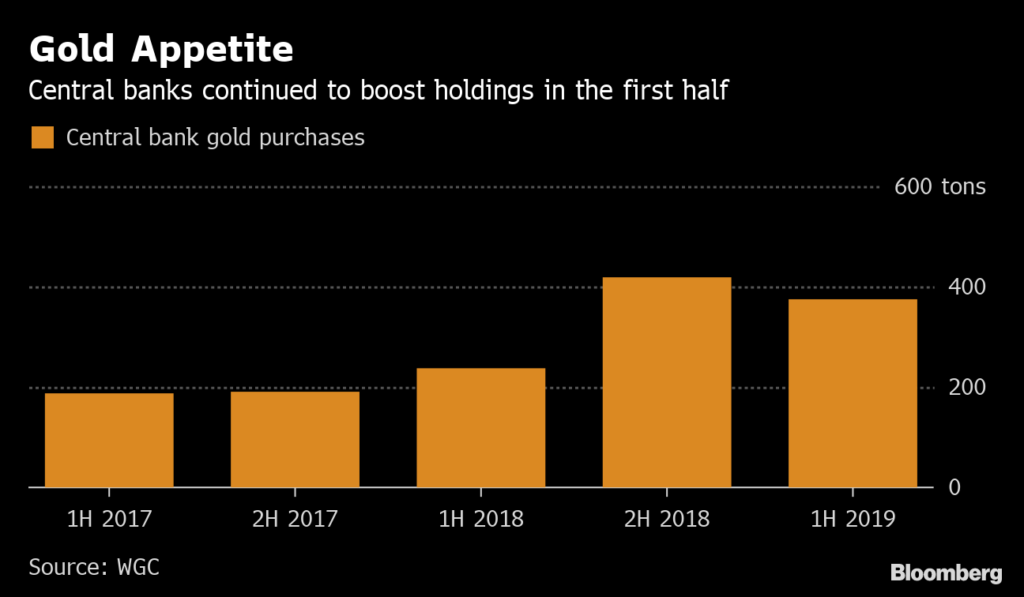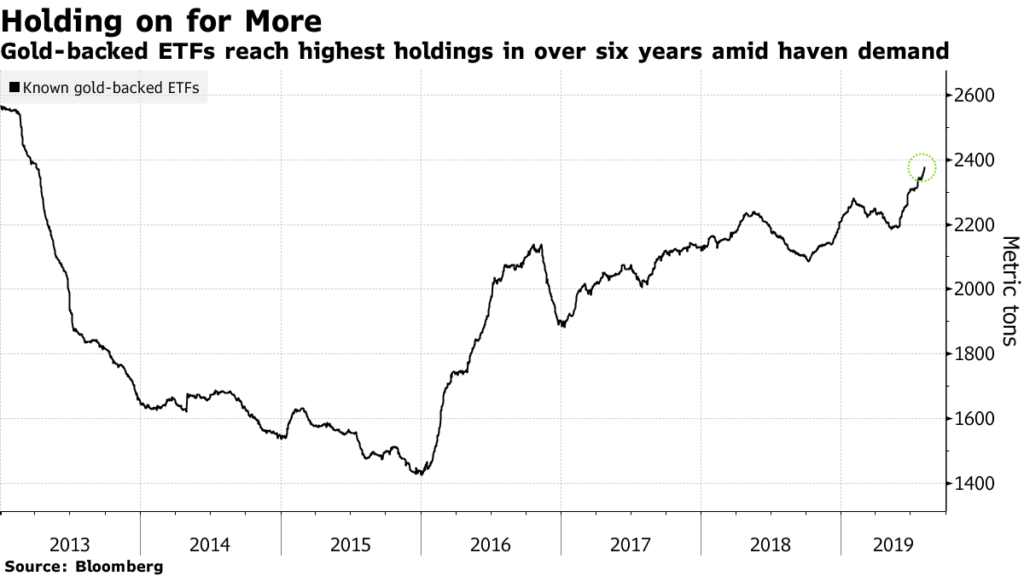Bloomberg is signaling the fact that in the first six months of the year countries all over the world have bought over 370 tons of gold, pushing the demand for the precious metal to a three-month high. This has caused gold price to climb to the highest level in the last six years.
The Russian and Chinese central banks` increasing gold holdings particularly stand out, but also massive purchases by the Central Bank of Poland. This is a global trend which does not seem to come to a halt any time soon. According to Bloomberg, a recent central bank survey shows that 54% of respondents expect the trend to continue in the next 12 months.
If we take China and Russia alone, one of their main reasons is to obviously diversify central bank reserves away from the dollar. The geopolitical tensions between them and the US, as well as the latter`s appetite for economic sanctions have pushed some countries to find ways of lowering their dependence on the American currency and dollar-based payments systems.

But this is just one of the explanations. The National Bank of Poland bought 100 tons of gold in the second quarter of this year alone and cannot be suspected of trying to hedge against American sanctions. Moreover, globally government gold holdings have increased by 14% in the past ten years.
These developments are pointing to another cause. I believe that an important, though unspoken reason, is the turning on of the money printing machine by the main central banks that issue the currencies which usually make up central bank reserves. This is undoubtedly an increasingly justified concern. The money printing policies have thrown the largest central banks into uncharted territory and their implications are currently only partly visible on the financial markets in the “bubbles” created on the debt and even the stock market. In this context, we should highlight one of the consequences which is the abnormal stock market behavior of welcoming the Fed`s monetary policy to cut rates to preempt recession with new record highs.
As other instruments are lacking and interest rates are already low, the main central banks seem again ready to resume quantitative easing by buying their own government bonds. In other words, by printing even more money. Is it better under the circumstances to keep your wealth in such currencies or you may be better off switching to a new asset, such as gold, which cannot be multiplied at the stroke of a pen? The amount of gold available worldwide can only go up by mining more gold out of the ground. Compare the mind-boggling increases in the central bank balance sheets to the 1.3% annual increase in the amount of gold existing in the light of day.
Given all this, should we also start buying gold as a safeguard against central banks` money printing machine? This is trickier than it looks.
Firstly, it is crucial not to forget that gold has to be part of a savings or investment portfolio. Under no circumstances is it recommended to put all your savings into gold, as it is an asset that has proved volatile over time. The gold holding in a portfolio serves as an “insurance policy” against extreme events. When all assets collapse during crisis years there are some safe haven assets which perform well and are counter cyclical. Gold is one of them.
This is a strategy that we, at BCR Pensions, use for our two private pension funds under management, which according to the latest Financial Supervisory Authority statistics are the only pension funds in Romania with exposure to gold. The exposure, however, is not done by physically keeping ingots in a vault. And that takes me to the next point.
Before deciding to add gold to your portfolio, you need to correctly estimate the associated costs. Buying and physically holding gold is the most expensive. This is mainly due to the large differences between the buy and sell price, even when the gold is in the custody of the selling bank. And by the way, custodian services always come at a price. If it is not left with the bank, redeeming the gold will hurt your pocket even more.
A more interesting alternative in this case would be to use exchange-traded instruments whose price closely varies with the price of gold and feature a relatively low difference between the buy and sell prices. The price of the financial instrument is made to move with the gold price by the fact that each instrument is backed by stored physical bullion or by gold derivatives.
Instruments backed by physical gold kept with a large third-party custodian bank seem more appealing to me because the counterparty risk is minimized. There is a range of such ETFs/ETCs backed by physical bars and which, in addition, at the holder`s request, can be interchanged with the underlying gold bars. In other words, ETCs may be turned into gold to be physically shipped after payment, of course, of related transport and security costs.
Investing in gold-backed ETFs/ETCs has clearly soared lately, a trend also reflected by Bloomberg`s graph below.

It will be ultimately up to each individual to decide whether investing in gold, a non-interest-bearing asset, but a haven asset in times of crisis is the answer to a long period of negative real and even nominal interest rates, accompanied by renewed increases in the money supply to levels never thought possible a decade earlier.
Given the current setting, it will be interesting to see as well the strategy the National Bank of Romania will use for its own reserves, unchanged for a very long period..
Have a nice weekend!



